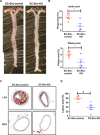Mechanical forces regulate endothelial-to-mesenchymal transition and atherosclerosis via an Alk5-Shc mechanotransduction pathway
- PMID: 34244146
- PMCID: PMC8270486
- DOI: 10.1126/sciadv.abg5060
Mechanical forces regulate endothelial-to-mesenchymal transition and atherosclerosis via an Alk5-Shc mechanotransduction pathway
Abstract
The response of endothelial cells to mechanical forces is a critical determinant of vascular health. Vascular pathologies, such as atherosclerosis, characterized by abnormal mechanical forces are frequently accompanied by endothelial-to-mesenchymal transition (EndMT). However, how forces affect the mechanotransduction pathways controlling cellular plasticity, inflammation, and, ultimately, vessel pathology is poorly understood. Here, we identify a mechanoreceptor that is sui generis for EndMT and unveil a molecular Alk5-Shc pathway that leads to EndMT and atherosclerosis. Depletion of Alk5 abrogates shear stress-induced EndMT responses, and genetic targeting of endothelial Shc reduces EndMT and atherosclerosis in areas of disturbed flow. Tensional force and reconstitution experiments reveal a mechanosensory function for Alk5 in EndMT signaling that is unique and independent of other mechanosensors. Our findings are of fundamental importance for understanding how mechanical forces regulate biochemical signaling, cell plasticity, and vascular disease.
Copyright © 2021 The Authors, some rights reserved; exclusive licensee American Association for the Advancement of Science. No claim to original U.S. Government Works. Distributed under a Creative Commons Attribution License 4.0 (CC BY).
Figures






References
-
- Davies P. F., Barbee K. A., Volin M. V., Robotewskyj A., Chen J., Joseph L., Griem M. L., Wernick M. N., Jacobs E., Polacek D. C., DePaola N., Barakat A. I., Spatial relationships in early signaling events of flow-mediated endothelial mechanotransduction. Annu. Rev. Physiol. 59, 527–549 (1997). - PubMed
Grants and funding
LinkOut - more resources
Full Text Sources
Research Materials
Miscellaneous

